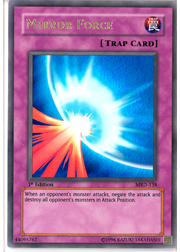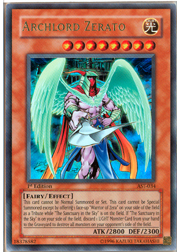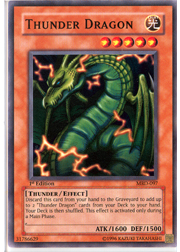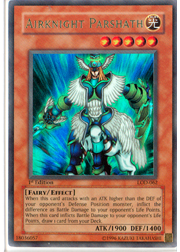One of the most important components of a highly successful deck is the ability to handle a large number of opposing monsters without wrecking your own board position in the process. For the past six months, Dark Hole and Torrential Tribute were the cards of choice in this regard. Players had to watch how many monsters they summoned at a time, because unless those two cards had already been played, there was a huge chance that their opponent would immediately play one of them when things became too unbalanced. The biggest conundrum (at least in the case of Dark Hole) was the total unavoidability of the thing. Unless you had a counter-trap or a spell-immune monster (neither of which saw any real play in the previous format) it would cost you your field . . . and a Spirit Reaper or Don Zaloog was pretty much guaranteed to follow.
 This time around, things have changed quite a bit. Dark Hole has been traded for Mirror Force, and the mass removal dynamic has taken a new turn. You still have to keep your summoning in check to avoid Torrential Tribute, but now the only other way to lose your army is sloppy attack plans or the chance that your opponent has something unexpected up his or her sleeve. I’m inclined to believe that most players at the Shonen Jump Top 8 level are good enough to play around Mirror Force, which leaves us to find alternate ways of clearing Dark World- and Cyber Dragon-induced swarms. You could use Lightning Vortex: while it doesn’t trigger Dark World effects, preliminary Regional reports suggest that its popularity is on the rise. Needle Ceiling is another choice, though it has a requirement of four monsters on the field and takes out your own face-up cards as well. What I’m really looking for, however, is a Raigeki-like effect, preferably one that I can use multiple times per game without the aid of Magician of Faith. Is there such a card? Of course there is—and using it successfully is one of the most gratifying experiences you can have with the Yu-Gi-Oh! TCG. The following deck is designed to make good use of it.
This time around, things have changed quite a bit. Dark Hole has been traded for Mirror Force, and the mass removal dynamic has taken a new turn. You still have to keep your summoning in check to avoid Torrential Tribute, but now the only other way to lose your army is sloppy attack plans or the chance that your opponent has something unexpected up his or her sleeve. I’m inclined to believe that most players at the Shonen Jump Top 8 level are good enough to play around Mirror Force, which leaves us to find alternate ways of clearing Dark World- and Cyber Dragon-induced swarms. You could use Lightning Vortex: while it doesn’t trigger Dark World effects, preliminary Regional reports suggest that its popularity is on the rise. Needle Ceiling is another choice, though it has a requirement of four monsters on the field and takes out your own face-up cards as well. What I’m really looking for, however, is a Raigeki-like effect, preferably one that I can use multiple times per game without the aid of Magician of Faith. Is there such a card? Of course there is—and using it successfully is one of the most gratifying experiences you can have with the Yu-Gi-Oh! TCG. The following deck is designed to make good use of it.
“Judgment Day”
Monsters: 20
2 Archlord Zerato
3 Warrior of Zera
2 Airknight Parshath
3 Thunder Dragon
1 D. D. Warrior Lady
2 Magician of Faith
2 Skelengel
3 Mirage Dragon
2 Shining Angel
Spells: 11
3 The Sanctuary in the Sky
1 Graceful Charity
1 Pot of Avarice
1 Lightning Vortex
2 Nobleman of Crossout
1 Terraforming
1 Premature Burial
1 Book of Moon
Traps: 10
3 Sakuretsu Armor
1 Mirror Force
3 Light of Judgment
1 Torrential Tribute
1 Call of the Haunted
1 Spell Shield Type-8
 I must confess, I’ve maligned Archlord Zerato in the past, but only because of the effort required to use it in comparison to Raigeki or Dark Hole. Those cards are currently forbidden for just that reason: too easy to work and therefore too powerful. Zerato is a more balanced incarnation of every Traditional player’s favorite thunderbolt-dropping spell, and it’s a ton of fun to play.
I must confess, I’ve maligned Archlord Zerato in the past, but only because of the effort required to use it in comparison to Raigeki or Dark Hole. Those cards are currently forbidden for just that reason: too easy to work and therefore too powerful. Zerato is a more balanced incarnation of every Traditional player’s favorite thunderbolt-dropping spell, and it’s a ton of fun to play.
The deck works by first clearing the field every turn with Zerato, and then attacking unimpeded, thanks to Mirage Dragon. During the course of the game, you should be able to bolster your hand through Thunder Dragon and various other draw effects, and use Light of Judgment to help stop threats before they start. That’s right: I said, “before they start,” and if you just pulled out an Ancient Sanctuary copy of the card from your pile of commons, I’ll bet you’re a little bit confused.
First of all, there’s been a clarification issued on the text of Light of Judgment. The card now specifies that you get to look at the opponent’s hand while deciding what card to send to the graveyard. It specifies that the card is sent to the graveyard rather than discarded. That means that Dark World monsters don’t get their effects if you choose to send them to the graveyard with Light of Judgment’s effect.
Second, there’s a play etiquette issue concerning Mirage Dragon that I’d like to address. If you’re playing with the card on the field, please make sure you clarify what’s happening to your opponent as you’re moving through the phases of the turn. Do not just pick up a card and declare an attack, expecting to skip through your first main phase. Who knows? Maybe your opponent has a Call of the Haunted or Dust Tornado that he or she would like to use before the battle phase after seeing what you’re going to commit to the board in main phase 1. Of course, if your opponent activates anything when you declare your intent to go to battle, you can still take other actions in your main phase before you try to move to battle again. But it’s important to keep an open line of communication between yourself and your opponent. That way, everyone understands what’s happening at a given time, which will drastically reduce the number of unnecessary arguments during the game.
Finally, you should note that Light of Judgment is not a targeting effect, and that unlike Archlord Zerato, its effect still resolves correctly even if The Sanctuary in the Sky is removed from the field in response to its activation. That should deal with most of the rulings quandaries that might come up when you’re playing the deck, so let’s move on to how you want to play it.
 Ideally, you’ll want to get the Thunder Dragons out of your deck as soon as possible — on your very first turn, if you’ve got one. Naturally, drawing more than one Thunder Dragon is horrible, so I usually try to avoid it whenever possible. Here, though, you need Light monsters in your hand, and Thunder Dragon is the most easily accessible in the deck. You can also do some fun tricks with Thunder Dragon and Pot of Avarice. Discard one to fetch the others, discard another one to Zerato or Lightning Vortex or Light of Judgment, then use Pot of Avarice to put the first two back into your deck, along with a few other monsters. Then draw your two cards, and (assuming you didn’t hit another Thunder Dragon) discard your remaining one to go fetch the others again. You’ll be surprised how often this deck can pull off that stunt.
Ideally, you’ll want to get the Thunder Dragons out of your deck as soon as possible — on your very first turn, if you’ve got one. Naturally, drawing more than one Thunder Dragon is horrible, so I usually try to avoid it whenever possible. Here, though, you need Light monsters in your hand, and Thunder Dragon is the most easily accessible in the deck. You can also do some fun tricks with Thunder Dragon and Pot of Avarice. Discard one to fetch the others, discard another one to Zerato or Lightning Vortex or Light of Judgment, then use Pot of Avarice to put the first two back into your deck, along with a few other monsters. Then draw your two cards, and (assuming you didn’t hit another Thunder Dragon) discard your remaining one to go fetch the others again. You’ll be surprised how often this deck can pull off that stunt.
The next step is to see what your opponent is up to and plan accordingly. The first few turns will ideally be spent building up some cards in hand and on the field through Skelengel, Shining Angel and the two Magician of Faiths. An early (but not too early) Graceful Charity goes a long way towards setting up your win. And getting Light of Judgment off on turn 2 or 3 gives you a massive advantage over your opponent, similar to that of an early Confiscation (though it won’t become a dead card in later turns like that card does). Making the right calls with Light of Judgment is a key factor in consistently dropping Zerato and keeping it alive.
Another key factor is Mirage Dragon and its dark brethren Pitch-Black Warwolf. Both are excellent cards in this format, since they make Mirror Force, Sakuretsu Armor, and Widespread Ruin totally useless. Any deck out there can benefit from such a boon, and quite honestly, I’m surprised that I don’t see either of them in more Chaos decks. (Heck, on the subject of cards we don’t see very much, where’s the love for Exarion Universe and Airknight Parshath? Those cards destroy the guy who’s hiding behind those Spirit Reapers. Airknight is especially nasty in this regard, given the bonus draw it provides for the low, low price of at least one of your opponent’s life points. Remember, your opponent has thousands of life points. Don’t feel bad about taking some of them . . . or all of them, for that matter.)
 Speaking of taking things, Airknight Parshath is a key component of this deck’s ability to take control of the game and keep the opponent from stopping Archlord Zerato. The extra draws are huge, and every potentially bad topdeck you get out of the way with an Airknight is one less bad topdeck waiting for you if your opponent manages to stabilize after you drop Zerato. Summoning the Archlord works a lot like summoning a high level monster by special summoning Cyber Dragon and immediately tributing it. The main difference is that in this case you do the normal summon first with Warrior of Zera, and then the special summon with Archlord Zerato.
Speaking of taking things, Airknight Parshath is a key component of this deck’s ability to take control of the game and keep the opponent from stopping Archlord Zerato. The extra draws are huge, and every potentially bad topdeck you get out of the way with an Airknight is one less bad topdeck waiting for you if your opponent manages to stabilize after you drop Zerato. Summoning the Archlord works a lot like summoning a high level monster by special summoning Cyber Dragon and immediately tributing it. The main difference is that in this case you do the normal summon first with Warrior of Zera, and then the special summon with Archlord Zerato.
Remember, when you successfully summon Zerato, you can retain priority to activate its effect, so when you finally get it out, you’re almost guaranteed to get one Judgment BoltTM off before your opponent has a chance to use Bottomless Trap Hole. If you’ve timed it right, though, he or she shouldn’t have much in the way of responses to the summon and shouldn’t be able to stop the attack, so just go to town. Two hits from Mirage Dragon and Archlord Zerato is enough to win the game.
Many people are quick to point out that this deck can produce some pretty foul hands sometimes, and they’re right. It’s more than possible to get a horrible hand playing this deck, but then again, that can happen with any deck. Four Monarchs without any way to summon them are just as bad as a double-Archlord, double-Sanctuary hand without Warrior of Zera. While this deck, like all field spell-based decks, is more prone to bad hands than other decks in the format, it’s still currently the only deck out there that can claim the effect of Raigeki every turn. High risk, high reward. The only way it could get riskier is if I was fetching out Time Wizard with Apprentice Magician. Actually, that’s a good idea for a future deck . . .
In any case, I recommend giving this deck a try at your local Hobby League, assuming you have the cards for it. A lot of them became commons in Dark Revelation 2, though the Archlord can often be difficult to find. If you can, however, it should be relatively easy to trade for. Enjoy your Raigeki Advanced!
Until next time, play hard, play fair, and most importantly, have fun!
Jerome McHale
jcmchale@andrew.cmu.edu
NEXT WEEK: A deck to appease your inner kleptomaniac.